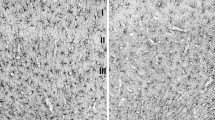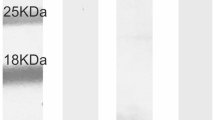Abstract
GFAP expression patterns were compared between the brains of a spiny dogfish (Squalus acanthias) and a little skate (Raia erinacea). After anesthesia, the animals were perfused with paraformaldehyde. Serial vibratome sections were immunostained against GFAP using the avidin-biotin method. Spiny dogfish brain contained mainly uniformly-distributed, radially arranged ependymoglia. From GFAP distribution, the layered organization in both the telencephalon and the tectum were visible. In the cerebellum, the molecular and granular layers displayed conspicuously different glial structures; in the former a Bergmann glia-like population was found. No true astrocytes (i.e., stellate-shaped cells) were found. Radial glial endfeet lined all meningeal surfaces. Radial fibers also seemed to form endfeet and en passant contacts on the vessels. Plexuses of fine perivascular glial fibers also contributed to the perivascular glia. Compared with spiny dogfish brain, GFAP expression in the little skate brain was confined. Radial glia were limited to a few areas, e.g., segments of the ventricular surface of the telencephalon, and the midline of the diencephalon and mesencephalon. Scarce astrocytes occurred in every brain part, but only the optic chiasm, and the junction of the tegmentum and optic tectum contained large numbers of astrocytes. Astrocytes formed the meningeal glia limitans and the perivascular glia. No GFAP-immunopositive Bergmann glia-like structure was found. Astrocytes seen in the little skate were clearly different from the mammalian and avian ones; they had a different process system – extra large forms were frequently seen, and the meningeal and perivascular cells were spread along the surface instead of forming endfeet by processes. The differences between Squalus and Raia astroglia were much like those found between reptiles versus mammals and birds. It suggests independent and parallel glial evolutionary processes in amniotes and chondrichthyans, seemingly correlated with the thickening of the brain wall, and the growing complexity of the brain. There is no strict correlation, however, between the replacement of radial ependymoglia with astrocytes, and the local thickness of the brain wall.
Similar content being viewed by others
Author information
Authors and Affiliations
Additional information
Accepted: 6 March 2001
Rights and permissions
About this article
Cite this article
Kálmán, M., Gould, R. GFAP-immunopositive structures in spiny dogfish, Squalus acanthias, and little skate, Raia erinacea, brains: differences have evolutionary implications. Anat Embryol 204, 59–80 (2001). https://doi.org/10.1007/s004290100180
Issue Date:
DOI: https://doi.org/10.1007/s004290100180




